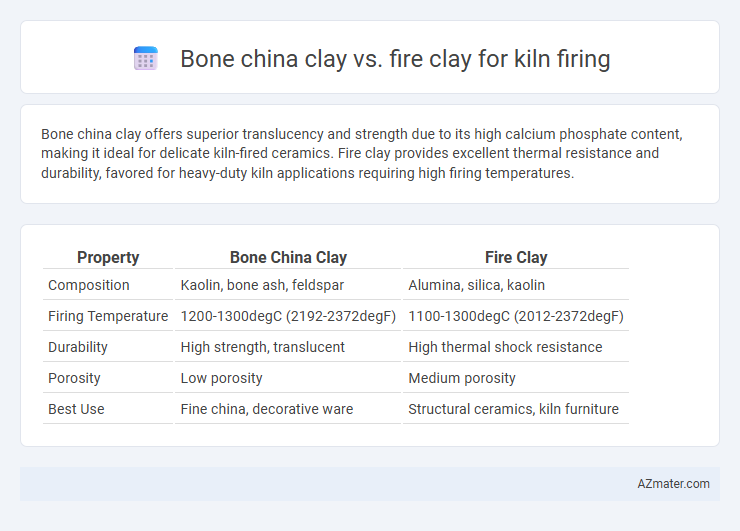Bone china clay offers superior translucency and strength due to its high calcium phosphate content, making it ideal for delicate kiln-fired ceramics. Fire clay provides excellent thermal resistance and durability, favored for heavy-duty kiln applications requiring high firing temperatures.
Table of Comparison
| Property | Bone China Clay | Fire Clay |
|---|---|---|
| Composition | Kaolin, bone ash, feldspar | Alumina, silica, kaolin |
| Firing Temperature | 1200-1300degC (2192-2372degF) | 1100-1300degC (2012-2372degF) |
| Durability | High strength, translucent | High thermal shock resistance |
| Porosity | Low porosity | Medium porosity |
| Best Use | Fine china, decorative ware | Structural ceramics, kiln furniture |
Introduction to Bone China Clay and Fire Clay
Bone china clay contains bone ash, feldspar, and kaolin, creating a translucent, high-strength porcelain ideal for fine tableware and kiln firing at around 1200-1250degC. Fire clay consists primarily of refractory alumina and silica, known for its excellent heat resistance and durability, commonly used in kiln linings and heavy-duty ceramics fired at higher temperatures between 1300-1500degC. The mineral composition and firing temperature differences differentiate bone china clay's delicate, smooth finish from fire clay's robust, heat-resistant properties.
Composition and Mineral Content
Bone china clay contains a high percentage of bone ash (approximately 30-50%), kaolin, and feldspar, which provide translucency and whiteness ideal for fine ceramics; its calcium phosphate content enhances vitrification during kiln firing at around 1200-1250degC. Fire clay, composed mainly of refractory alumina and silica minerals with minimal organic matter, offers high thermal stability and durability, making it suitable for kiln linings and firing temperatures above 1300degC. The mineral content differences influence thermal expansion and plasticity, with bone china clay enabling delicate porcelain bodies, while fire clay withstands extreme heat without deformation.
Physical Properties Comparison
Bone china clay exhibits higher translucency and a finer particle size compared to fire clay, making it ideal for delicate, thin-walled ceramics. Fire clay demonstrates greater thermal shock resistance and higher refractory properties, suitable for kiln firing at elevated temperatures and more robust applications. The plasticity of bone china clay is lower, whereas fire clay offers superior workability and durability during repeated firings.
Workability and Handling Differences
Bone china clay offers superior plasticity and smooth workability, making it ideal for intricate moldings and delicate shaping during kiln firing. Fire clay, with its coarse texture and higher refractory properties, handles higher firing temperatures but is less pliable, requiring stronger tools and more effort for detailed work. The distinct particle size and composition differences dictate bone china's fine, refined finish versus fire clay's rugged, durable characteristics in ceramic production.
Firing Temperature Requirements
Bone china clay typically requires firing temperatures between 1200degC and 1280degC to achieve its translucent, delicate finish, making it ideal for fine tableware. Fire clay is more refractory, tolerating higher firing temperatures around 1300degC to 1400degC, which makes it excellent for heat-resistant ceramics and kiln furniture. Understanding these distinct temperature ranges ensures optimal vitrification and durability depending on the ceramic application.
Shrinkage and Warping Concerns
Bone china clay typically exhibits lower shrinkage during kiln firing, around 6-8%, compared to fire clay which can shrink up to 12%, reducing warping risks in delicate ceramic pieces. Fire clay's higher refractory content makes it more resistant to thermal shock but also more prone to uneven shrinkage and warping, especially in thicker forms. Selecting bone china clay minimizes deformation for fine, thin-walled ceramics, while fire clay suits robust, heat-resistant applications despite greater shrinkage variability.
Final Product Strength and Durability
Bone china clay contains bone ash, which enhances vitrification, resulting in a final product with exceptional strength, translucency, and durability after kiln firing. Fire clay, known for its high refractory properties, withstands higher firing temperatures but typically produces a denser, less translucent final product with moderate strength and durability. The choice between bone china clay and fire clay depends on whether the priority is fine, delicate strength with aesthetic qualities or high thermal resistance and robustness for industrial applications.
Aesthetic Outcomes: Color and Finish
Bone china clay produces a smooth, translucent white finish prized for its delicate, refined aesthetic, making it ideal for fine tableware and decorative pieces. Fire clay yields a denser, more opaque surface with a naturally earthy tone that enhances rustic or utilitarian designs. The choice between bone china and fire clay significantly influences the firing temperature and glaze response, directly impacting the final color vibrancy and surface texture of kiln-fired ceramics.
Suitability for Various Ceramic Applications
Bone china clay offers exceptional translucency and strength, making it highly suitable for fine tableware and decorative ceramics that require delicate, refined finishes. Fire clay boasts higher refractory properties and thermal shock resistance, ideal for heavy-duty kiln firing applications such as kiln shelves, firebricks, and industrial ceramics. Selecting between bone china and fire clay depends on whether the ceramic piece demands aesthetic elegance or robust heat tolerance during kiln firing.
Cost and Availability Considerations
Bone china clay typically costs more than fire clay due to its refined composition and rarity, making it less accessible for large-scale kiln firing projects. Fire clay is widely available and more affordable, favored for its versatility and high refractory properties in industrial and artisanal kiln applications. Cost-effectiveness and material accessibility often lead manufacturers to choose fire clay when budget constraints and consistent supply are critical factors.

Infographic: Bone china clay vs Fire clay for Kiln firing
 azmater.com
azmater.com